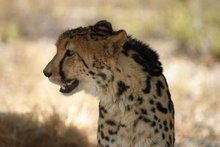
OK your probably thinking "bee always write about Cats and mammal carnivores why'd he suddenly change to snakes?" awns er is i care for all animals and here it is the endangered Eastern massasaugas rattlesnake
S. c. catenatus is not a large snake, with adults ranging from 45 to 75 cm in length. Its color pattern consists of a grey or tan ground color with a row of large rounded brown/black blotches or spots down the centre of the back and three smaller rows of alternating spots down each side. Solid black melanistic examples are also known, as well as cases where the back blotches join with those on the sides. A rattle is present on the tail. Young massasauga rattlesnakes are well-patterned but paler than the adults. This is the only Ontario snake with vertical pupils. It has heat-sensing pits on each side of its smallish head, the scales are keeled and the anal scale is single.
and of cause lets talk bout the venom, The venom of rattlesnakes contains specialized digestive enzymes that disrupt blood flow and prevent blood clotting. Severe internal bleeding causes the death of the small animals that this snake eats. After envenomation, the rattlesnake is able to withdraw from the dangers of sharp toothed prey animals until they are subdued and even partially digested by the action of the venom.
S. c. catenatus is rather shy and avoids humans when it can. Most massasauga snakebites in Ontario have occurred after people deliberately handled or accidentally stepped on one of these animals. Both of these scenarios are preventable by avoiding hiking through areas of low visibility (in rattlesnake country) when not wearing shoes and long pants, and by leaving the massasaugas alone when they are found. There are only two recorded incidents of people dying from massasauga rattlesnake bites in Ontario and in both cases they did not receive proper treatment. In at least one of these cases, the victim was a young child.
and on a finishing note S. c. catenatus is listed by a number of states as an endangered species, although it does not have any designation on the United States federal Endangered Species Act. The two subspecies found in the drier areas of the southwestern United States and northern Mexico are also considered endangered or at risk by some state governments



No comments:
Post a Comment